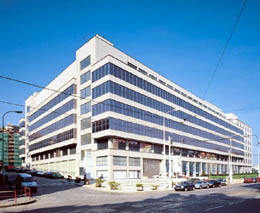
Ten years ago, the Prague Veletržní Palace returned to life
 |
The building, which is an architectural unique, was built according to the design of architects Josef Fuchs and Oldřich Tyl from 1925 to 1928 for the Prague Sample Trade Fairs Company. It amazed not only with its vastness and overall concept but also with its rational approach. The gigantic structure has eight above-ground and two underground floors and extensive exhibition halls. The entrance hall, bordered by galleries, passed through all floors, and below it was a cinema hall two stories high. The café and restaurant on the eighth floor with a large viewing terrace offered fresh views of the capital.
The building is one of the largest functionalist achievements in Europe. It was appreciated by the famous modern architect Le Corbusier during his visit to Prague in 1928. However, it was not intended to remain just this one building. A self-sufficient exhibition city was planned to grow in Holešovice with two palaces (the second on the site of today’s Parkhotel) and accompanying buildings for administration and services.
After the fire that completely destroyed the palace and caused damage of hundreds of millions of crowns, the building was condemned to demolition. However, after many disputes, it was acquired by the National Gallery in Prague at the end of the 1970s. Subsequently, work began on plans to utilize the space for modern art collections. The National Gallery could only present its treasures in various exhibitions because it did not have sufficient space.
The nearly decade-long reconstruction of the building, which was accompanied by several changes in the opening date, ultimately cost a billion crowns. Among the architects most deserving of the revival of the landmark are Otakar Binar, John Eisler, Karel Hubáček, Miroslav Masák, and Emil Přikryl. The establishment of the new permanent exhibition of the National Gallery was marked by a series of managerial changes, controversial statements, speculation, and financial discrepancies. The palace saw its reconstruction officially completed only in 1995, and it was ceremoniously opened on December 13.
The first visitors of the permanent exhibition of modern art were then President Václav Havel and Prime Minister Václav Klaus. The day after, the palace opened to the public. The first short-term exhibition was dedicated to the cubist artist Otto Gutfreund.
According to the then director of the NG Martin Zlatohlávek, it was Jiří Kotalík, director of the NG from 1967 to 1990, who contributed the most to making the Trade Fair Palace a venue for modern Czech art. Kotalík expressed that he was extremely happy about the palace's opening, but "only halfway." His idea was to create a large center for contemporary art in the palace, encompassing architecture, scenography, glasswork, and design, which he felt was lacking in the exhibitions.
The current permanent exhibition of 19th, 20th, and 21st-century art introduces the development of visual art over the last two centuries in three floors of the palace. Over 2,000 exhibits by Czech and foreign authors are placed on an area of 13,500 square meters. It also includes examples of architecture, furniture, artistic crafts, fashion, design, and scenography, along with photographs, drawings, and graphics.
The English translation is powered by AI tool. Switch to Czech to view the original text source.
0 comments
add comment
Related articles
0
11.12.2015 | The Trade Fair Palace will continue to serve art, the National Gallery is also considering a new building
1
11.08.2014 | <Veletržní palác> has been serving art for 20 years, in the future it may not be like that
0
19.03.2014 | The Story of the Trade Fair Palace - Invitation to the Exhibition
0
20.06.2013 | Director of the Trade Fair Palace: We need repairs for 250 million











